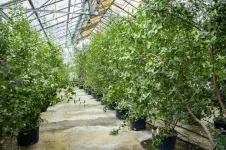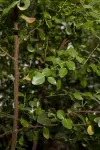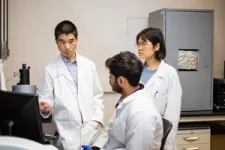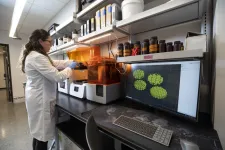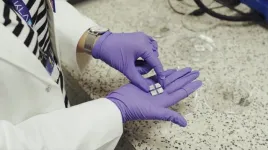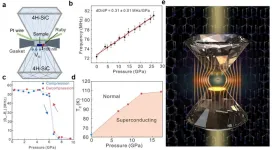(Press-News.org) The medicinal secrets of the Chilean soapbark tree have been laid bare, unlocking a future of more potent, affordable, and sustainably sought vaccines.
The evergreen species, Quillaja saponaria has, for decades, been highly prized for producing molecules called QS saponins, which are used in the food and drinks industry as foaming agents.
More recently an important new function has emerged with saponins obtained from the tree’s bark used as potent adjuvants in the production of vaccines. Adjuvants play a critical role in some vaccines, working to boost the potency of a vaccine by enhancing the host immune response.
Molecules extracted from soapbark tree are used as adjuvants in vaccines protecting people against COVID-19, shingles, and malaria.
QS saponins are sourced directly from the tree and although this is at a much smaller scale than the food and drink industry, vaccine manufacturers are actively working to reduce the environmental impact and improve sustainability of sourcing these important resources.
Researchers at the John Innes Centre have taken a major step forward in addressing this problem, by using a combination of genome mining and bioengineering techniques to produce saponin-based vaccine adjuvants in the laboratory without harvesting material directly from trees.
Dr James Reed, first author of the study and postdoctoral researcher at the John Innes Centre says: “These are complex molecules that have thwarted attempts to synthesize them at scale using chemistry in the lab. After many twists and turns, we have now discovered the core set of genes responsible for the biosynthesis of QS saponins.”
In research which appears in Science, the Osbourn group at the John Innes Centre first sequenced the genome of Quillaja saponaria. Then they used powerful computational gene-mining tools to predict which among the ~30,000 genes that make up its genome were responsible for saponin biosynthesis.
This led to the identification of a biosynthetic pathway of 16 genes which together produce the enzymes which are nature's building blocks for saponin production. Together these newly discovered genes and enzymes act as an instruction manual for future adjuvant bioengineering, say the team.
Identification of a further three enzymes resulted in a complete biosynthetic pathway to the saponin QS-7, a saponin that is included in a vaccine adjuvant with proven clinical efficacy, but that is notoriously difficult to purify from soapbark tree.
The pathway to these molecules was reconstructed in a plant called Nicotiana benthamiana, using a rapid and powerful technique called transient combinatorial expression.
This dwarf wild relative of tobacco is well known as an amenable host for the bioproduction of therapeutic proteins and pharmaceuticals.
The team is already using this instruction manual to attempt to produce other valuable saponins including QS-21, a potent adjuvant and key component in human vaccines.
The levels of saponins produced in this study equate to amounts normally obtained from the leaves of the soapbark tree rather than its bark.
The team have partnered with Plant Bioscience Limited (PBL, Norwich UK), who are leading on the commercialisation of the research and are now looking to work with commercial and academic partners to scale up these quantities further.
Professor Anne Osbourn, the lead of the study, and a group leader at the John Innes Centre said: “The COVID-19 pandemic has demonstrated the huge demand for lifesaving vaccines. By assembling the genome sequence of Quillaja saponaria we now have the instruction manual which has enabled us to decode how the tree makes these potent medicinal molecules. This opens the possibility of producing known and new-to-nature saponin-based vaccine adjuvants optimized for immunostimulant activity and suitable for human applications in our rapid transient plant expression system.”
Elucidation of the pathway for biosynthesis of saponin adjuvants from the soapbark tree appears in Science.
Vaccine Adjuvants - a brief timeline
Described as hidden helpers, vaccine adjuvants are immunostimulatory substances that are added to some vaccines to boost the immune response, doing so by inducing strong antibody and T-cell responses.
Until recently the only adjuvants in clinical use were insoluble aluminium salts or oil in water emulsions containing squalene, an organic compound obtained from shark liver.
As natural surfactants, saponins have been used in veterinary medicine for a century. But these adjuvants have been unsuitable for human use due to poor tolerability. A vaccine containing a saponin-based adjuvant has been approved for use in humans.
QS-7 and QS-21 are included in a complex mix of saponins formulated as Matrix-M adjuvant in the Novavax COVID 19 vaccine. Approval of this vaccine in countries worldwide is increasing the interest for saponin-based adjuvants and alternative methods of production.
Knowledge of the biosynthetic pathway will enable researchers to develop bespoke saponin-based adjuvants with a diverse spectrum of immune-stimulating properties.
END
Can insights from the soapbark tree change the way we make vaccines?
The medicinal secrets of the Chilean soapbark tree have been laid bare, unlocking a future of more potent, affordable, and sustainably sought vaccines
2023-03-23
ELSE PRESS RELEASES FROM THIS DATE:
Autism rates continue to rise in California
2023-03-23
A new report from the Centers for Disease Control and Prevention (CDC) shows the rates and demographics of children with autism spectrum disorder (ASD) are changing in the United States.
In the latest analysis, 1 in 36 8-year-old children (2.8%) have been identified as having ASD. This figure is higher than the previous estimate published in December 2021, which found a prevalence of 1 in 44 (2.3%) children, and considerably higher than the CDC’s first autism prevalence report published in 2007 noting a prevalence of 1 in 150 (0.7%).
Prevalence estimates also differed across the 11 data collection sites, ranging from 1 in 43 children (2.3%) in Maryland, to 1 in 22 (4.5%) ...
Artificial intelligence predicts genetics of cancerous brain tumors in under 90 seconds
2023-03-23
Using artificial intelligence, researchers have discovered how to screen for genetic mutations in cancerous brain tumors in under 90 seconds — and possibly streamline the diagnosis and treatment of gliomas, a study suggests.
A team of neurosurgeons and engineers at Michigan Medicine, in collaboration with investigators from New York University, University of California, San Francisco and others, developed an AI-based diagnostic screening system called DeepGlioma that uses rapid imaging to analyze tumor specimens taken during an operation and detect genetic mutations more rapidly.
In a study of more than 150 patients ...
SLU research finds improved wastewater treatment could lead to significant reduction in greenhouse gas emissions
2023-03-23
ST. LOUIS – Research published in Environmental Research Letters has shown that methane emissions from urban areas are underestimated by a factor of three to four and that untreated wastewater may be a contributing factor.
The study, “Investigating high methane emissions from urban areas detected by TROPOMI and their association with untreated wastewater,” was led by Benjamin de Foy, Ph.D., professor of Earth and Atmospheric Sciences at Saint Louis University, and published online on ...
What really matters in multi-story building design?
2023-03-23
The impact of multi-storey building design considerations on embodied carbon emissions, cost, and operational energy has been revealed for the first time.
Using a computer model, researchers estimate that up to six gigatonnes of carbon could be saved by 2050 if new multi-storey buildings follow certain recommendations during the design process. All these recommendations, which could also save between 28 and 44% of annual heating and cooling costs, use technology that is currently available.
Construction and operation of buildings account for more than one-third ...
UTEP joins project to 3D print batteries from lunar and Martian soil
2023-03-23
EL PASO, Texas (March 23, 2023) – The University of Texas at El Paso has joined a project led by NASA to leverage 3D-printing processes with the aim of manufacturing rechargeable batteries using lunar and Martian regolith, which is the top layer of materials that covers the surface of the moon and Mars.
“UTEP is a national leader in additive manufacturing for space applications,” said Kenith Meissner, Ph.D., dean of the UTEP College of Engineering. “I congratulate the team of UTEP researchers involved in this important work. I am confident their work will add significant value ...
For stressed-out grad students, mindfulness makes big difference
2023-03-23
MADISON – While recent studies and polls indicate the nation is in the midst of a mental health crisis, the situation in academia is even more grim: Within the high-stress, high-pressure, often socially isolated world of advanced education, graduate students experience depression and anxiety at six times the rate of the general population.
Normalizing mindfulness practices within the graduate student experience may be an answer, according to a three-year study conducted by University of Wisconsin–Madison ...
Alzheimer's early detection through biomarkers -
2023-03-23
Scientists from Swansea University ‘s Institute for Innovative Materials, Processing and Numerical Technologies (IMPACT) and Japan have been awarded £1.3 million to develop a new “point of care testing” kit that can detect biomarkers for Alzheimer's Disease.
The project follows Dr Sanjiv Sharma’s ground-breaking work in this area and the development of the world’s first COVID-19 ‘smart patch’.
Compared to hypodermic single needles, a ‘smart patch’ consists of a collection of tiny needles - microneedles - created to break the skin barrier in a minimally invasive ...
Rates of autism climb to new highs in the U.S., with California setting record numbers
2023-03-23
New federal studies coauthored by autism experts at Rutgers found that more children have been diagnosed with autism than at any time since monitoring began more than two decades ago.
According to the U.S. Centers for Disease Control and Prevention (CDC), about 4 percent of 8-year-old boys and 1 percent of 8-year-old girls, have autism in the U.S. These estimates are the highest since the CDC’s Autism and Developmental Disabilities Monitoring (ADDM) Network was created in 2000.
Biennial studies from the ADDM Network, which analyzed ...
Study uncovers aspect of how muscular dystrophies progress
2023-03-23
A research study has shed new light on how congenital muscular dystrophies such as Walker-Warburg syndrome progress, bringing hope for better understanding, early diagnosis and treatments of these fatal disorders.
Published in March in the Journal of Biological Chemistry, the research was led by scientists in the lab of Vlad Panin, Ph.D., professor in the Department of Biochemistry and Biophysics in the Texas A&M College of Agriculture and Life Sciences. The study is titled “Protein tyrosine phosphatase 69D is a substrate of protein O-mannosyltransferases 1-2 that is required for the wiring of sensory axons in Drosophila.” ...
Researchers make breakthrough in high-pressure magnetic detection
2023-03-23
According to a study published in Nature Materials, a collaborative research team from the Hefei Institutes of Physical Science of the Chinese Academy of Sciences (CAS) and the University of Science and Technology of China has developed a research platform to study superconducting magnetic detection and magnetic phase transitions of hydrides under high pressure.
High-resolution in-situ magnetic measurement under high pressure has been a challenge. It has limited the progress of research on the Meissner effect of superconductivity and on magnetic phase transition behavior under high pressure. Using the optically detected ...
LAST 30 PRESS RELEASES:
Numbers in our sights affect how we perceive space
SIMJ announces global collaborative book project in commemoration of its 75th anniversary
Air pollution exposure and birth weight
Obstructive sleep apnea risk and mental health conditions among older adults
How talking slows eye movements behind the wheel
The Ceramic Society of Japan’s Oxoate Ceramics Research Association launches new international book project
Heart-brain connection: international study reveals the role of the vagus nerve in keeping the heart young
Researchers identify Rb1 as a predictive biomarker for a new therapeutic strategy in some breast cancers
Survey reveals ethical gaps slowing AI adoption in pediatric surgery
Stimulant ADHD medications work differently than thought
AI overestimates how smart people are, according to HSE economists
HSE researchers create genome-wide map of quadruplexes
Scientists boost cell "powerhouses" to burn more calories
Automatic label checking: The missing step in making reliable medical AI
Low daily alcohol intake linked to 50% heightened mouth cancer risk in India
American Meteorological Society announces Rick Spinrad as 2026 President-Elect
Biomass-based carbon capture spotlighted in newly released global climate webinar recording
Illuminating invisible nano pollutants: advanced bioimaging tracks the full journey of emerging nanoscale contaminants in living systems
How does age affect recovery from spinal cord injury?
Novel AI tool offers prognosis for patients with head and neck cancer
Fathers’ microplastic exposure tied to their children’s metabolic problems
Research validates laboratory model for studying high-grade serous ovarian cancer
SIR 2026 delivers transformative breakthroughs in minimally invasive medicine to improve patient care
Stem Cell Reports most downloaded papers of 2025 highlight the breadth and impact of stem cell research
Oxford-led study estimates NHS spends around 3% of its primary and secondary care budget on the health impacts of heat and cold in England
A researcher’s long quest leads to a smart composite breakthrough
Urban wild bees act as “microbial sensors” of city health.
New study finds where you live affects recovery after a hip fracture
Forecasting the impact of fully automated vehicle adoption on US road traffic injuries
Alcohol-related hospitalizations from 2016 to 2022
[Press-News.org] Can insights from the soapbark tree change the way we make vaccines?The medicinal secrets of the Chilean soapbark tree have been laid bare, unlocking a future of more potent, affordable, and sustainably sought vaccines
